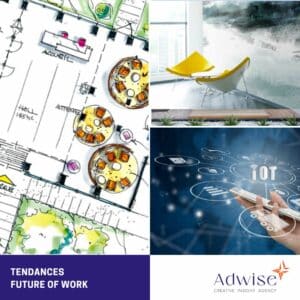
Since the pandemic, hybrid working has emerged as a new organisational model for companies. Long-term teleworking and a return to the office have given rise to new ways of organising the workplace. In this changing environment, new solutions are emerging from a variety of angles, to rethink the employee experience at every stage of their journey within the company. But how? By designing, among other things, intelligent and user-friendly workspaces to better satisfy employees (greater flexibility, quality of life and well-being at work).
An overview of the most significant trends with our strategic planner, who spoke with experts from the #FutureOfWork ecosystem, in particular at the last edition of the trade fair. simi last December in Paris.
- With the advent of partial teleworking, the hybridization of spaces is giving rise to new forms of work. resimercial" design for employee well-being. Adapted to professional use, these spaces are "just like home", conducive to human contact and conviviality, with attractive, comfortable furniture to make employees want to come back to the company.
- Flex office or hot desking. The traditional desk is a thing of the past, and it's time to move on to the nomadic desk, which can accommodate any employee in these spaces to encourage flexibility and social relations. This means less monotony and more motivation and synergy between colleagues.
- Satellite spaces or intelligent open spaces. For greater privacy on open-plan workstations, we are seeing the emergence of office pods/cabins that provide employees with a workspace for greater efficiency and improved well-being. This equipment is perfectly suited to the hybrid ecosystem of layouts.
- The smart office to optimise working conditions, simplify day-to-day life and optimise exchanges within the teams. This working environment connected uses technologies such as the Internet of Things (IoT), artificial intelligence (AI) and automation. The smart office can include energy consumption management, presence detection and automated meeting management.
- The green office - The workspaces are composed using natural elements to enhance well-being, such as plants and wood materials. Employees working in this type of environment report an improvement in mood, well-being, creativity and productivity.
Beyond the effects of fashion, the design of workspaces has become an important issue for companies in order to facilitate management and attract and retain employees. Companies need to anticipate the change in use of the office to become a place where people can live and exchange ideas in this period of phygital workplace change.




